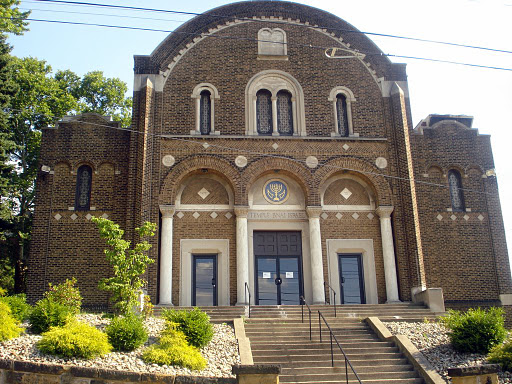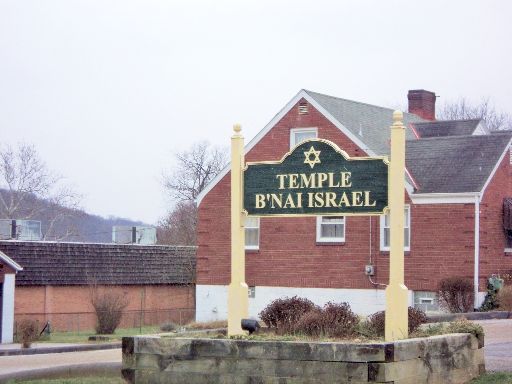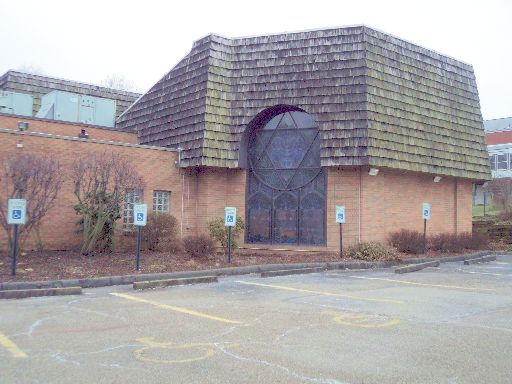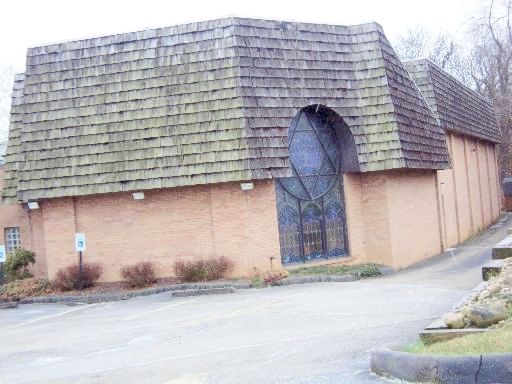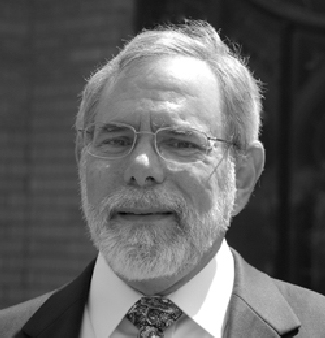THE HISTORY OF TEMPLE B'NAI ISRAEL
by
Leonard MARTIN
(Historian)
|
While the first congregation McKeesport, Gamilis Chesed (Distributors of Kindness) was an Orthodox congregation, some members who complained that the dues were raised too much formed the Ahavas Achem (Brothers of Love) congregation. The rented a room on Paw Paw Alley as its house of worship and obtained a charter in 1890.
|
Compared to Gamilis Chesed, the other Jewish congregations and McKeesport were small. The Germans, Russians and Lithuanians united into Congregation B'nai Israel, which hired Liederkrantz Hall in 1886 for the high holiday services and secured its charter in 1890. but the Russians and Lithuanians broke away and organized the Tree of Life, an Orthodox congregation, which after a few years of existence in the charter in 1898. Without support, McKeesport's B'nai Israel congregation, with a membership of twenty-five families in 1894, were mainly German and leaned toward Reform Judaism soon dissolved. Some Reform Jews began sending their children on the Baltimore and Ohio Railroad every week to Sunday school at the Rodef Sholom synagogue in Pittsburgh.
|
Fifty family members from other congregations organize B'nai Israel in 1912, the first conservative congregation in Allegheny County, outside of Pittsburgh. It's its leader, Attorney Frank R. S. KAPLAN, having been brought from Vilna province Lithuania as a child, married the daughter of Jacob ROTH and later became president of the copper will Corporation. Occupying a wooden building on genuine street B'nai Israel used English recitations in its ritual and an caught up in membership with McKeesport's major synagogue the Hungarian Gamilis Chesed, which use Hebrew only.
|
About a score of men gathered in the store room of Joseph RUBEN on the evening of 4 October 1912, to hear Rabbi Joseph ZEISLER expound the necessity of a modern Jewish congregation in the City of McKeesport. After a free and spirited discussion, those present declared themselves in favor of a modern congregation—of a conservative type—and proceeded to select temporary officers with fullpower to arrange all details of organizations. The officers chosen were A. M. SIMON, Esq., (President), Eugene KROW (Secretary) and Samuel FIRESTONE (Treasurer). Rabbi ZEISLER was authorized to solicit funds for such immediate expenses as might be required and succeeded in collecting a total of $665. dollars, subscibed by the following: J. H. RUBEN, Henry FRIEDMAN, S. FIRESTONE, A. M. SIMON, Gus KENT, I. SUNSTEIN, O. JUBELIRER, I. JUBELIRER, Lee J. BACHMAN, L. ENGELMAN, H. FLASTER, Dr. N. SUNSTEIN, David HIRSHBERG, A. KIMELMAN, Dr. M. H. BACHMAN, R. MORITZ, Dr. M. E. COHN, J. POLLEVOI, A. M. AMPER, Israel A. SIMON, A. TEPLITZ, Max HIRSHBERG, Herman GOLDBERG, Lee HIRSHBERG, Myer KANT, F. BRODER, Eugene KROW, Morris KROW, Weill BROS, Julius DEGNER, Eugene GOLDBERG, R. RUBENSTEIN, M. MALLOY and Charles STEIN.
|
The search for a place of worship resulted in the leasing of the Talmud Torah Quarters on Jenny Lind Street, owned by the A.H.H. congregation of Market Street. The committee spent considerable time and money in transforming the building suitable for divine services. Rabbi ZEISLER, following some misunderstanding, decided to leave and the search for a spiritual head for the congregation commenced. After paying the expenses of several who were not found suitable, the committee applied to the Jewish Theologlcal Seminary in New York, and as a result, Rabbi Louis BRAY arrived 20 July 1913. Rabbi BRAY addressed the members present, created a favorable impression and was elected as the first Rabbi of the Congregation.
|
A reorganization then took place and the following officers were elected: , Frank R. S. Kaplan (President), A. M. AMPER (Vice-President), Eugene KROW (Secretary) and S. FIRESTONE (Treasurer). A board of directors, with power to have charge of the reorganized congregation and to prepare for divine services, etc., wereto F. R. S. KAPLAN, S. FIRESTONE, A. M. AMPER, Eugene KROW, Julius DEGNER, DR. N. SUNSTEIN, Simon KALKSTONE and Max HIRSHBERG. After the meeting at Ruben's Furniture Store, The search was on for a suitable place of worship. The building on Jenny Lind Street was acquired. Their and him and him and himI first act was to secure 30 signers to a guarantee and the following were the guarantors.
|
The above 30 men thus became the actual founders of the congregation, and with these members, the Temple B'nai Israel started on its successful career.
|
When the property on Shaw and Lincoln was bought, it was the intention of the congregation to build the following Spring. However, the "gas craze" that winter changed all calculations. As it was expected that many of the members would become wealthy during this unexpected boom, the aspirations of the congregation increased accordingly. But disaster followed the boom and another year was wasted. Then came the year when, due to WWI war conditions, a building was declared non-essential and no materials could be obtained. Thus, 1919 passed in history with no building as yet. Then came 1920, with its inflated prices. In the fall of the year, the Board of Directors, unable to withstand the pressure of necessity any longer, entered into a search for architects, which resulted in the selection of Messrs. JALLADE, LINDSAY and WARREN, of New York City, who were then erecting the $600.00 Y.M.C.A. building in McKeesport. Plans were drawn, ready for building in 1921, when unfortunatly the financial condition of the country became such as to halt to any serious intentions which might have been held for building that year.
|
The building on Jenny Lind Street being sold, the Board took possession of the building on Shaw Avenue, on the site of the new Temple, had it remodeled and made into school rooms, with one large room with a seating capacity of 100 and furnished suitably for divine services. The winter of 1921 was spent in the cramped quarters and when the spring of 1922 made its appearance, the Board of Directors, spurred on by the danger nothing short of the still dangerous financial situation and not withstanding the objections made by many lukewarm members, bids were taken on the building and the contract awarded. Building operations were started in June and the ground broken with appropriate ceremonies. Chairman Simon KALKSTONE designated F. R. S. KAPLAN, Henry FRIEDMAN and Eugene KROW to break the ground. finally, the Temple at Shaw Avenue and Lincoln, seating 700 people, was completed, at a cost of $100,000. dollars.
|
In October, 1913, the first meeting of of the sisterhood was held at the home of Mrs. Noah SONSTEIN with 16 or 18 ladies in attendance. At this meeting, Mrs. Charles FRIEDMAN was chosen as its first president and served one year (term). Following her as President of the sisterhood were Mrs. Margaret ABEL (two terms), Mrs. Adolph KIMELMAN (one term), Mrs. Henry REITER (two terms) and Mrs. William KIMMELMAN (three terms).
|
|
